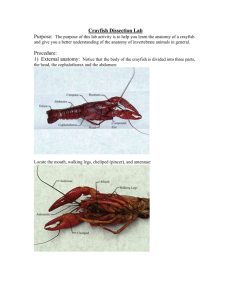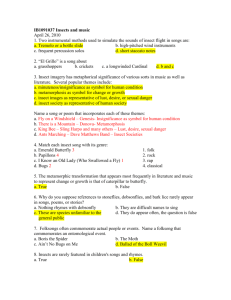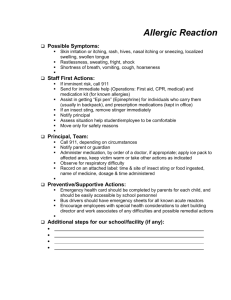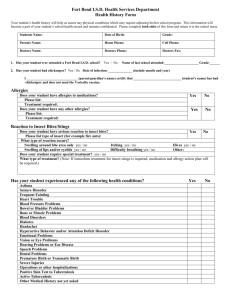BSC 2010L TA meeting - INVERTEBRATES II
advertisement
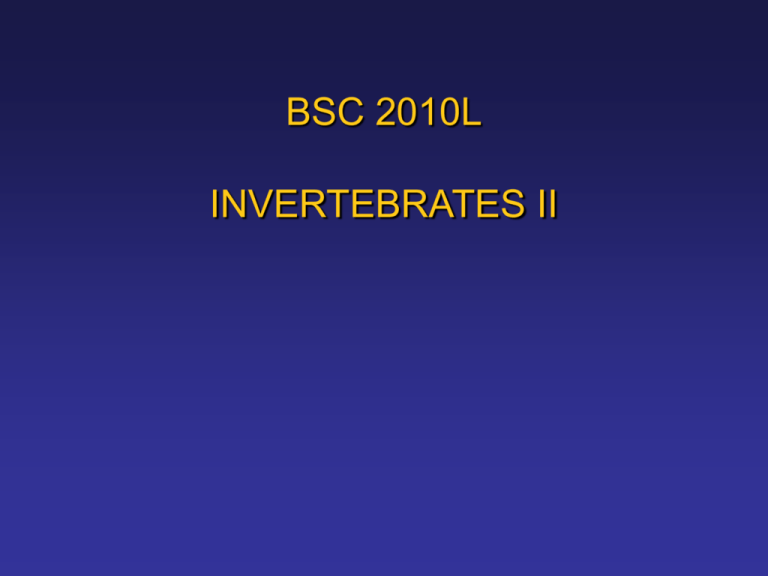
BSC 2010L INVERTEBRATES II Principal Biological Concepts to Emphasize: A. Protostome vs. deuterostome. B. Extremely diverse groups. C. Terrestrial adaptations of Arthropods. D. Serial homology. E. Evolution of flight. F. Metamorphosis. G. Detailed anatomy of the crayfish. Protostome vs. deuterostome. A. Mollusks and arthropods, as well as the Annelids we looked at last week, are protostomes. 1. 2. 3. B. Spiral and determinate cleavage Blastopore (opening of the archenteron) becomes the mouth Schizocoelous formation of the coelom We will look at deuterostome phyla next week (Echinodermata and Chordata) 1. 2. 3. Radial and indeterminate cleavage Blastopore forms anus Enterocoelous formation of coelom Early embryonic development Early development in protostomes and deuterostomes Phylum MOLLUSCA 1. 2. 3. 4. Class Polyplacophora - chitons Class Gastropoda - snails, slugs Class Bivalvia - bivalves Class Cephalopoda - octupus, squids Basic body plan of mollusks A chiton Garden snail The results of torsion in a gastropod Gastropods: Nudibranchs (top left and bottom left), terrestrial snail (bottom left), deer cowrie (bottom right) A bivalve: Scallop Anatomy of a clam Cephalopods: Squid (top left and bottom left), nautilus (top right), octopus (bottom right) Mussel heart xsec prepared (no. 11-1) Phylum ARTHROPODA 1. Subphylum Chelicerata a. b. 2. Subphylum Crustacea a. 3. class Merostomata - horseshoe crabs class Arachnida - spiders, ticks, scorpions class Crustacea - aquatic arthropods - shrimp, lobsters, crabs, crayfish Subphylum Uniramia a. b. c. class Insecta - flight class Chilopoda - centipedes class Diplopoda - millipedes Lycosid spider Arachnids. Scorpion (left), parasitic mites inhabiting tracheae of honeybee (right) Horseshoe crabs, Limulus polyphemus External anatomy of an arthropod Insecta: beetle Insect flight, dragonfly Metamorphosis of a butterfly Class Dipolopoda (millipedes) Malpighian tubules of insects Insect Malpighian tubules prepared (no. 11-2) Insect tracheae prepared (no. 11-3) Spider anatomy Grasshopper external anatomy and mouthparts Anatomy of a grasshopper, an insect Crayfish dissection A. WORK IN PAIRS. B. Photosheets are posted in lab. C. Dispose of crayfish in metal barrels in back of room. Insect identification - slides and dichotomous key. A. B. You must identify five (5) insect orders Hand this in before leaving lab as data sheet 2 (DS2 - 5 pts.) 1. 2. 3. C. D. E. Name Slide box number Slide number, insect order for each of 5 slides. Key to insect orders Don't share slide boxes. For lab practical - Don't need to know orders or the structures used in the key. Suggest you view “33A Characteristics of Invertebrates” on Student Media CD-ROM for review. Lab practical in three weeks. A. B. C. D. E. F. G. H. Sign up sheets available on-line beginning Monday, October 10. Review lab sessions - Saturday October 15 and Sunday October 16. Practical exams - Monday October 17 through Wednesday October 19. 30 stations 1 question per station 60 seconds per station NO GOING BACK Practical covers labs 1, 4, 5 and 7, in roughly equal proportions.
